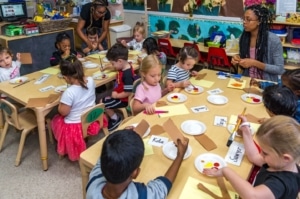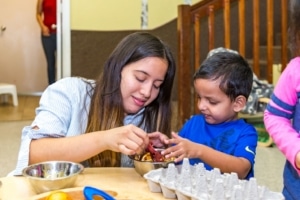A Joyful Place to Learn and Grow

Parker-Chase Preschool focuses on the developmental needs of all children by structuring our environment to match each child’s learning style.
Our environment, inside and outside, is rich in the materials young children require to grow physically, intellectually and emotionally. Every day your child will have the opportunity to explore all of the educational disciplines by delving into language arts, math, science, art, and music through projects and play.
Research Based & Individualized
Our curriculum is based on our knowledge of the developmental process, the individual child’s needs and interests, and the child’s family culture. With a focus on the “whole child,” we consider all areas of a child’s development — physical, language, social/emotional, and cognitive — to ensure they acquire an enjoyable and effective education.
Large and small group projects drive much of our curriculum. These projects involve:
- Routines and transitions
- Planned and spontaneous activities
- Indoor and outdoor play
- Interactions between children and between children and adults
- Child-led and teacher-directed activities
The Project Approach
Research has shown that we retain about 75% of what we do, compared to 5% of what we hear or 10% of what we read. In other words, you can tell a child how to ride a bike. However, that child won’t know how to ride a bike until he or she gets on one and tries. At Parker Chase, we use a project-based approach so children can learn by doing. 
In more traditional preschools or daycare centers, teachers often stand before the class explaining new concepts or skills, then students perform tasks such as worksheets to practice. This approach asks children to learn or memorize information based on what they are hearing and reading rather than engaging with content in ways that help children retain and apply information more broadly. Alternatively, the project approach offers:
- Hands-on activities that enable children to explore topics and materials that interest them
- Interactive activities help the child develop deep problem-solving skills as they seek answers to their questions through the scientific process
- Children are encouraged to reflect on what they are exploring during their projects, asking “why?” and “how” as they discover answers for themselves
- Rather than relying solely on worksheets or workbooks, children learn through engaging projects
- Comprehension and retention improve as children learn in a way that is more interesting and engaging to them
- A learning style which has been studied thoroughly for decades and proven to be beneficial, especially for young children
Project-Based, Experiential Learning
Children learn number concepts best by manipulating and counting real objects, rather than simply completing worksheets.
Our students are more engaged because we present concepts in a way that is interesting to them, allowing them to learn by doing, rather than solely by hearing and reading.
They learn while working toward larger, exciting goals, such as playing a coral-reef scavenger hunt or converting their classroom into a museum. High-interest learning centers and hands-on exploration support and extend children’s growing understandings in social-emotional skills, science, literacy, and mathematics.
Challenging and Trusting Each Child’s Capabilities
Children learn best when they are exposed to new things in interactive and interesting ways.
Rooted in best practices, our curriculum is designed to trust and challenge children’s capabilities. Our low student-teacher ratios ensure that our educators get to know each student and develop trusting relationships that help motivate them to reach his or her ultimate learning potential.
Balancing Work and Play to Develop Gross and Motor Skills
Exploration through purposeful, project-based play and movement gets the brain going! Studies show that the brain relies heavily on body movement, hands-on exploration and gross motor skills to fuel cognitive development. 
This is why learning is often most effective for children when presented in a way that is hands-on and interesting to them. We believe that learning can and should be joyful, involving both structure AND exploration, teacher guidance AND child discovery, laughter AND accelerated academics.
Children have the stamina to engage with challenging concepts when they are able to ‘play’ with ideas and manipulate learning materials with their hands. When content is linked to children’s interests, they cannot wait to come learn, discover, and grow.
Building Character, Leadership and Problem-Solving Skills
Our programs also include character-building activities that teach the importance of fairness, integrity, and honesty. This approach helps us develop young leaders who think more creatively and develop problem-solving abilities.
Indoor/Outdoor Learning
Rooted in research about the benefits of learning outside for young children, our program includes outdoor gardening and exploration. Why does going outside matter? Studies show that children are highly engaged when doing things outside with their hands. 
Unfortunately, many children today have a lack of outdoor time with a shift to screen time. At Parker Chase, we get students moving while also learning about the beauty and wonder of nature.
With indoor activity rooms, children continue to have opportunities for exercise and movement regardless of the weather.
What Does a Project-Based Curriculum Look Like?
Our unique curriculum allows children to work towards the development of key skills and knowledge of an array of subjects through group projects. For example, during the ‘Dinosaurs’ unit, preschoolers participated in a fun, interactive group project that taught them different subjects and skills:
MATH: Measuring and creating a life size dinosaur, counting dinosaur bones
SCIENCE: Categorizing dinosaurs, exploring the anatomy and diets of various dinosaurs, learning about the scientists who study dinosaurs
LITERACY: Reading informational texts and classic stories about dinosaurs; practicing writing while engaging in dramatic play as paleontologists; and building vocabulary as they learn a wide variety of words relating to dinosaurs and the scientists who study them
SOCIAL-EMOTIONAL: Working together and collaborating to transform the school’s Kiva into a dinosaur habitat and creating a life size dinosaur
Rooted in Children’s Interests, Supported by Engaged Educators

Teachers use a planning process that includes observation, assessment, developmental goals, developmentally appropriate practice and reflection. Based on this information, the curriculum emerges over time and guides how we set up the environment, the projects we support, experiences and interactions provided, and the routines and schedules within the classroom.
Our daily schedules allow for blocks of time for indoor and outdoor free-choice activities; small and large group activities; snacks and lunch; and routines, such as clean-up and toileting.
Classrooms are arranged in interest centers. During “center time,” children are encouraged to move around the classroom at their own pace and select activities of interest. During this time, teachers interact with children to extend or enhance their play by asking questions, supporting problem-solving, offering ideas or materials, and observing or assessing what children know.
